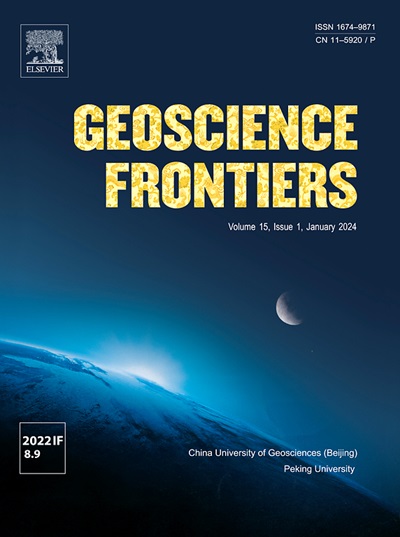How organic matter types in source rocks influence reservoir diagenesis: Evidence recorded in carbonate cements
IF 8.9
1区 地球科学
Q1 GEOSCIENCES, MULTIDISCIPLINARY
引用次数: 0
Abstract
Fluids generated from the source rocks containing various kerogen types at different thermal maturity stages control diagenetic processes and reservoir quality in adjacent sandstone reservoirs. This study focuses on the carbonate cements in the sandstones of the Lower Jurassic Yangxia Formation and the Ahe Formation in the Tarim Basin. The δ18O, δ13C, and 87Sr/86Sr data indicate that low‑temperature ferroan calcite and manganoan calcite—characterized by strongly negative δ13C values and enrichment in light rare‑earth elements (LREEs)—record CO2 released during the thermal degradation of organic matter predominantly composed of Type III kerogen in coal‑bearing source rocks and of Type II kerogen in mudstone source rocks, respectively. High‑temperature ferroan calcite and manganoan calcite, which exhibit similarly strongly negative δ13C values and enrichment in middle rare‑earth elements (MREEs), record organic acids and CO2 produced during the thermal decarboxylation of these same source rocks. The diagenetic fluid evolution sequence comprises early‑stage CO2 from thermal degradation of both coal‑bearing and mudstone source rocks; mid‑stage organic acids and CO2 from thermal decarboxylation of coal‑bearing source rocks; and late‑stage organic acids and CO2 from thermal decarboxylation of mudstone source rocks. Fluids generated during the thermal degradation of mudstone and coal‑bearing source rocks precipitated extensive calcite cements, leading to reservoir densification. Clumped isotope thermometry indicates that the primary generation periods of late‑stage mudstone‑derived fluids coincided with the formation of effective fractures. Feldspar dissolution along these fractures produced an interconnected network of fractures and dissolution pores, significantly enhancing reservoir quality in the Ahe Formation.

烃源岩有机质类型如何影响储层成岩作用:碳酸盐胶结物记录的证据
不同热成熟阶段含不同类型干酪根的烃源岩所产生的流体控制着邻近砂岩储层的成岩作用和储层质量。本文以塔里木盆地下侏罗统阳夏组和阿河组砂岩中的碳酸盐胶结物为研究对象。δ18O、δ13C和87Sr/86Sr数据表明,低温铁方解石和锰方解石的δ13C值为负,且富集轻稀土元素(lree),分别记录了含煤烃源岩中以ⅲ型干酪根为主和泥岩烃源岩中以ⅱ型干酪根为主的有机质热降解过程中释放的CO2。高温铁方解石和锰方解石δ13C值均为负,且中稀土元素(mree)富集,记录了烃源岩热脱羧过程中产生的有机酸和CO2。成岩流体演化序列包括含煤烃源岩和泥岩烃源岩热降解产生的早期CO2;含煤烃源岩热脱羧产生的中期有机酸和CO2;泥岩烃源岩热脱羧产生的晚期有机酸和CO2。泥岩和含煤烃源岩热降解过程中产生的流体沉积了大量方解石胶结物,导致储层致密化。块状同位素测温表明,晚期泥岩源流体的初生期与有效裂缝的形成相吻合。长石沿这些裂缝的溶蚀作用形成了一个相互连接的裂缝和溶蚀孔网络,显著提高了阿河组的储层质量。
本文章由计算机程序翻译,如有差异,请以英文原文为准。
求助全文
约1分钟内获得全文
求助全文
来源期刊

Geoscience frontiers
Earth and Planetary Sciences-General Earth and Planetary Sciences
CiteScore
17.80
自引率
3.40%
发文量
147
审稿时长
35 days
期刊介绍:
Geoscience Frontiers (GSF) is the Journal of China University of Geosciences (Beijing) and Peking University. It publishes peer-reviewed research articles and reviews in interdisciplinary fields of Earth and Planetary Sciences. GSF covers various research areas including petrology and geochemistry, lithospheric architecture and mantle dynamics, global tectonics, economic geology and fuel exploration, geophysics, stratigraphy and paleontology, environmental and engineering geology, astrogeology, and the nexus of resources-energy-emissions-climate under Sustainable Development Goals. The journal aims to bridge innovative, provocative, and challenging concepts and models in these fields, providing insights on correlations and evolution.
 求助内容:
求助内容: 应助结果提醒方式:
应助结果提醒方式:


